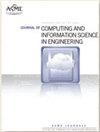A Comparison of Graph-Theoretic Approaches for Resilient System of Systems Design
IF 2.6
3区 工程技术
Q2 COMPUTER SCIENCE, INTERDISCIPLINARY APPLICATIONS
Journal of Computing and Information Science in Engineering
Pub Date : 2023-04-19
DOI:10.1115/1.4062231
引用次数: 0
Abstract
Abstract System of systems (SoS) are networked integration of constituent systems that together achieve new capabilities not possible through the operation of any single system. SoS can be found across all aspects of modern life such as power grids, supply chains, and disaster monitoring and tracking services. Their resilience (being able to withstand and recover from disruptions) is a critical attribute whose evaluation is nontrivial and requires detailed disruption models. Engineers rely on heuristics (such as redundancy and localized capacity) for achieving resilience. However, excessive reliance on these qualitative guidelines can result in unacceptable operation costs, erosion of profits, over-consumption of natural resources, or unacceptable levels of waste or emissions. Graph-theoretic approaches provide a potential solution to this challenge as they can evaluate architectural characteristics without needing detailed performance simulations, supporting their use in early stage SoS architecture selection. However, no consensus exists as to which graph-theoretic metrics are most valuable for SoS design and how they should be included in the design process. In this work, multiple graph-theoretic approaches are analyzed and compared, on a common platform, for their use as design tools for resilient SoS. The metrics central point dominance, modularity, specialized predator ratio, generalization, vulnerability, and degree of system order are found to be viable options for the development of early stage decision-support tools for resilient SoS design.系统设计中弹性系统的图论方法比较
系统的系统(so)是组成系统的网络集成,它们共同实现任何单一系统无法实现的新功能。SoS可以在现代生活的各个方面找到,例如电网,供应链以及灾难监测和跟踪服务。它们的弹性(能够承受中断并从中断中恢复)是一个关键属性,其评估是非平凡的,需要详细的中断模型。工程师依靠启发式(例如冗余和局部容量)来实现弹性。然而,过度依赖这些质量准则可能导致不可接受的业务成本、利润的侵蚀、自然资源的过度消耗或不可接受的废物或排放水平。图论方法为这一挑战提供了一个潜在的解决方案,因为它们可以在不需要详细的性能模拟的情况下评估体系结构特征,支持它们在早期SoS体系结构选择中的使用。然而,对于哪种图论指标对SoS设计最有价值,以及如何将它们包含在设计过程中,目前还没有达成共识。在这项工作中,多种图论方法在一个共同的平台上进行了分析和比较,以用作弹性SoS的设计工具。研究发现,中心点优势度、模块化、专业化捕食者比例、通用性、脆弱性和系统有序度等指标是弹性SoS设计早期决策支持工具开发的可行选择。
本文章由计算机程序翻译,如有差异,请以英文原文为准。
求助全文
约1分钟内获得全文
求助全文
来源期刊
CiteScore
6.30
自引率
12.90%
发文量
100
审稿时长
6 months
期刊介绍:
The ASME Journal of Computing and Information Science in Engineering (JCISE) publishes articles related to Algorithms, Computational Methods, Computing Infrastructure, Computer-Interpretable Representations, Human-Computer Interfaces, Information Science, and/or System Architectures that aim to improve some aspect of product and system lifecycle (e.g., design, manufacturing, operation, maintenance, disposal, recycling etc.). Applications considered in JCISE manuscripts should be relevant to the mechanical engineering discipline. Papers can be focused on fundamental research leading to new methods, or adaptation of existing methods for new applications.
Scope: Advanced Computing Infrastructure; Artificial Intelligence; Big Data and Analytics; Collaborative Design; Computer Aided Design; Computer Aided Engineering; Computer Aided Manufacturing; Computational Foundations for Additive Manufacturing; Computational Foundations for Engineering Optimization; Computational Geometry; Computational Metrology; Computational Synthesis; Conceptual Design; Cybermanufacturing; Cyber Physical Security for Factories; Cyber Physical System Design and Operation; Data-Driven Engineering Applications; Engineering Informatics; Geometric Reasoning; GPU Computing for Design and Manufacturing; Human Computer Interfaces/Interactions; Industrial Internet of Things; Knowledge Engineering; Information Management; Inverse Methods for Engineering Applications; Machine Learning for Engineering Applications; Manufacturing Planning; Manufacturing Automation; Model-based Systems Engineering; Multiphysics Modeling and Simulation; Multiscale Modeling and Simulation; Multidisciplinary Optimization; Physics-Based Simulations; Process Modeling for Engineering Applications; Qualification, Verification and Validation of Computational Models; Symbolic Computing for Engineering Applications; Tolerance Modeling; Topology and Shape Optimization; Virtual and Augmented Reality Environments; Virtual Prototyping

 求助内容:
求助内容: 应助结果提醒方式:
应助结果提醒方式:


